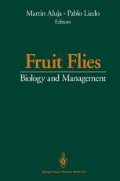Abstract
Resistance of many host plants to tephritid fruit flies is a well-documented fact. Often, susceptibility increases with senescence of the fruit. Different cultivars of related fruit species also show different levels of innate resistance to a given species of fruit fly (e.g., resistance of lemons >> oranges > grapefruit). Behavioral differences among fruit fly species (e.g., deposition of clutches of eggs vs. individual eggs) may account for observed differences in the destructive potential of individual pest species against a given type of fruit. Symbionts, especially bacterial agents, have been implicated in facilitating attack by fruit flies, and must be considered when examining host plant fruit fly interactions.
Access this chapter
Tax calculation will be finalised at checkout
Purchases are for personal use only
References
Fischer, D.C., Kogan, M., and Greany, P.D. 1990. Inducers of plant resistance to insects. In: Safer Insecticides: Development and Use ( Hodgson, E., and Kuhr, RJ., eds.). New York, Dekker. pp. 257–280.
Greany, P.D. 1989. Host plant resistance to tephritids: an underexploited control strategy. In: World Crop Pests: Fruit Flies-Biology, Natural Enemies and Control ( Robinson, A.S., and Hooper, G.H.S., eds.). Amsterdam, Elsevier. pp. 353–362.
Greany, P.D., McDonald, R.E., Shaw, P.E., Schroeder, W.J., Howard, D.F., Hatton, T.T., Davis, P.L., and Rasmussen, G.K. 1987. Use of gibberellic acid to reduce grapefruit susceptibility to attack by the Caribbean fruit fly Anastrepha suspensa ( Diptera: Tephritidae). Trop. Sci. 27: 261–270.
McDonald, RE., Greany, P.D., Shaw, P.E., Schroeder, W.J., Hatton, T.T., and Wilson, C.W. 1988. Use of gibberellic acid for Caribbean fruit fly (Anastrepha suspensa) control in grapefruit. In: Proc. Sixth Int. Soc. Citriculture, Goren, R, and Mendel, K, eds. Margraf Sci. Books, Weikersheim. pp. 37–43
McDonald, RE., Shaw, P.E., Greany, P.D., Hatton, T.T., and Wilson, C.W. 1987. Effect of gibberellic acid on certain physical and chemical properties of grapefruit. Trop. Sci. 27: 17–22.
Rossler, Y., and Greany, P.D. 1990. Enhancement of citrus resistance to the Mediterranean fruit fly. Entomol. Exp. Appt 54: 89–96.
Editor information
Editors and Affiliations
Rights and permissions
Copyright information
© 1993 Springer Science+Business Media New York
About this paper
Cite this paper
Greany, P. (1993). Elucidating the Biochemical Bases for Host Plant Selection and Manipulating Resistance to Tephritids. In: Aluja, M., Liedo, P. (eds) Fruit Flies. Springer, New York, NY. https://doi.org/10.1007/978-1-4757-2278-9_66
Download citation
DOI: https://doi.org/10.1007/978-1-4757-2278-9_66
Publisher Name: Springer, New York, NY
Print ISBN: 978-1-4757-2280-2
Online ISBN: 978-1-4757-2278-9
eBook Packages: Springer Book Archive

